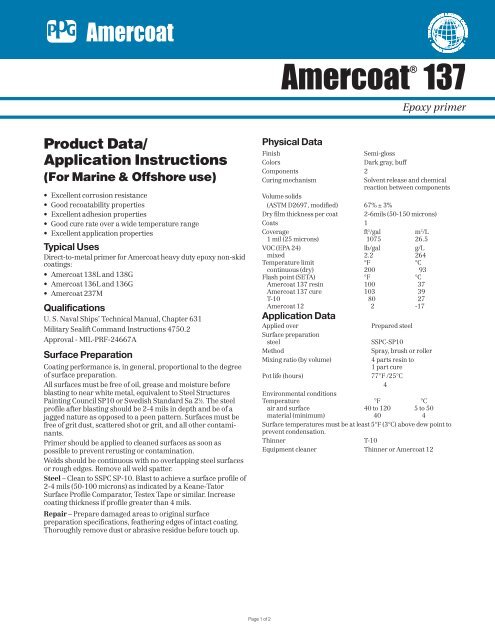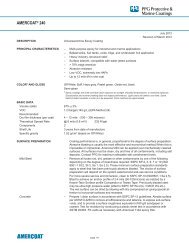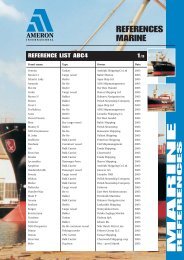Amercoat® 137 - PPG Protective & Marine Coatings
Amercoat® 137 - PPG Protective & Marine Coatings
Amercoat® 137 - PPG Protective & Marine Coatings
Create successful ePaper yourself
Turn your PDF publications into a flip-book with our unique Google optimized e-Paper software.
Amercoat<br />
Product Data/<br />
Application Instructions<br />
(For <strong>Marine</strong> & Offshore use)<br />
• Excellent corrosion resistance<br />
• Good recoatability properties<br />
• Excellent adhesion properties<br />
• Good cure rate over a wide temperature range<br />
• Excellent application properties<br />
Typical Uses<br />
Direct-to-metal primer for Amercoat heavy duty epoxy non-skid<br />
coatings:<br />
• Amercoat 138L and 138G<br />
• Amercoat 136L and 136G<br />
• Amercoat 237M<br />
Qualifications<br />
U. S. Naval Ships’ Technical Manual, Chapter 631<br />
Military Sealift Command Instructions 4750.2<br />
Approval - MIL-PRF-24667A<br />
Surface Preparation<br />
Coating performance is, in general, proportional to the degree<br />
of surface preparation.<br />
All surfaces must be free of oil, grease and moisture before<br />
blasting to near white metal, equivalent to Steel Structures<br />
Painting Council SP10 or Swedish Standard Sa 2 1 ⁄2. The steel<br />
profile after blasting should be 2-4 mils in depth and be of a<br />
jagged nature as opposed to a peen pattern. Surfaces must be<br />
free of grit dust, scattered shot or grit, and all other contaminants.<br />
Primer should be applied to cleaned surfaces as soon as<br />
possible to prevent rerusting or contamination.<br />
Welds should be continuous with no overlapping steel surfaces<br />
or rough edges. Remove all weld spatter.<br />
Steel – Clean to SSPC SP-10. Blast to achieve a surface profile of<br />
2-4 mils (50-100 microns) as indicated by a Keane-Tator<br />
Surface Profile Comparator, Testex Tape or similar. Increase<br />
coating thickness if profile greater than 4 mils.<br />
Repair – Prepare damaged areas to original surface<br />
preparation specifications, feathering edges of intact coating.<br />
Thoroughly remove dust or abrasive residue before touch up.<br />
Page 1 of 2<br />
Amercoat ®<br />
Physical Data<br />
<strong>137</strong><br />
Epoxy primer<br />
Finish Semi-gloss<br />
Colors Dark gray, buff<br />
Components 2<br />
Curing mechanism Solvent release and chemical<br />
reaction between components<br />
Volume solids<br />
(ASTM D2697, modified) 67% ± 3%<br />
Dry film thickness per coat 2-6mils (50-150 microns)<br />
Coats 1<br />
Coverage ft 2 /gal m 2 /L<br />
1 mil (25 microns) 1075 26.5<br />
VOC (EPA 24) lb/gal g/L<br />
mixed 2.2 264<br />
Temperature limit °F °C<br />
continuous (dry) 200 93<br />
Flash point (SETA) °F °C<br />
Amercoat <strong>137</strong> resin 100 37<br />
Amercoat <strong>137</strong> cure 103 39<br />
T-10 80 27<br />
Amercoat 12 2 -17<br />
Application Data<br />
Applied over Prepared steel<br />
Surface preparation<br />
steel SSPC-SP10<br />
Method Spray, brush or roller<br />
Mixing ratio (by volume) 4 parts resin to<br />
1 part cure<br />
Pot life (hours) 77°F /25°C<br />
4<br />
Environmental conditions<br />
Temperature °F °C<br />
air and surface 40 to 120 5 to 50<br />
material (minimum) 40 4<br />
Surface temperatures must be at least 5°F (3°C) above dew point to<br />
prevent condensation.<br />
Thinner T-10<br />
Equipment cleaner Thinner or Amercoat 12
Shipping Data<br />
Packaging units 5 gal monopack<br />
cure 1 gal in 1-gal can<br />
resin 4 gal in 6-gal can<br />
Shipping weight (approx)<br />
5-gal can<br />
lb kg<br />
cure 8.7 03.9<br />
resin 51.6 23.4<br />
Shelf life when stored indoors at 40 to 100°F (4 to 38°C)<br />
cure and resin 1 year from shipment date<br />
Numerical values are subject to normal manufacturing tolerances, colors and<br />
testing variances. Allow for application losses and surface irregularities.<br />
This product is photochemically reactive as defined by the South Coast Air Quality<br />
Management District's Rule 102 or equivalent regulations.<br />
Adhere to all application instructions, precautions, conditions<br />
and limitations during storage, handling, application and<br />
drying periods to obtain the maximum performance. For<br />
conditions outside the requirements or limitations described,<br />
contact your <strong>PPG</strong> representative.<br />
Application Equipment<br />
The following is a guide; suitable equipment from other manufacturers<br />
may be used. Changes in pressure, hose and tip size may be needed for<br />
proper spray characteristics.<br />
Airless spray – Standard equipment with 30 to 1 pump ratio or<br />
greater, with a 0.019- to 0.025-inch (0.48 mm to 0.63 mm) fluid tip.<br />
Conventional spray – Industrial equipment, such as DeVilbiss MBC or<br />
JGA or Binks 18 or 62 spray gun. A moisture and oil trap in the main air<br />
supply line, a pressure material pot with mechanical agitator and<br />
separate regulators for air and fluid pressure are recommended.<br />
Application Procedure<br />
Amercoat <strong>137</strong> primer can be applied by both conventional air spray<br />
and airless spray equipment.<br />
For air spray application, a fluid tip of .070” to .086” (DeVilbiss E and D<br />
tips) and an air cap with good break-up such as DeVilbiss 704 or 765<br />
will give good results. The fluid pressure should be kept low, about 15<br />
PSI, with just enough air pressure to get good break-up of the coating.<br />
Excessive air pressure can cause overspray problems.<br />
Where airless equipment is used, a 30 to 1 pump and .021” to .023” tip<br />
size will provide a good spray pattern. Ideally, fluid hoses should not be<br />
less than 3 ⁄8” ID and not longer than 50 feet, not including short 1 ⁄4” ID<br />
whips. Larger diameter hoses should be used for long fluid lines. Long<br />
fluid lines with narrow hoses will greatly reduce fluid pressure at the<br />
gun, causing poor spray patterns.<br />
For touch-up work, Amercoat <strong>137</strong> primer can be applied by brush or<br />
roller. Care should be taken that proper and uniform film thicknesses<br />
are obtained.<br />
Mixing and Thinning<br />
Amercoat <strong>137</strong> primer is a two component product supplied in 5 gallon<br />
monopack kits which contain the proper ratio of resin and cure. The<br />
entire contents of each container must be mixed together.<br />
Power mix the resin portion first to obtain a smooth, homogeneous<br />
condition. After mixing the resin portion, add the cure slowly with<br />
continued agitation. After the cure add is complete, continue to mix<br />
slowly for 15 minutes.<br />
Thinning is not normally required or desired; however, at lower<br />
temperatures, up to 10% T-10 thinner can be added depending on local<br />
VOC and air quality regulations. Any solvent addition should be made<br />
after the two components are thoroughly mixed.<br />
The pot life of the mixed material is 4 hours at 77°F (25°C). Higher<br />
temperatures will reduce working life of the coatings; lower temperatures<br />
will increase it.<br />
www.ppgpmc.com<br />
Safety Precautions<br />
Read each component’s material safety data sheet before use.<br />
Mixed material has hazards of each component. Safety precautions<br />
must be strictly followed during storage, handling and use.<br />
CAUTION – Improper use and handling of this product can be<br />
hazardous to health and cause fire or explosion.<br />
Do not use this product without first taking all appropriate<br />
safety measures to prevent property damage and injuries.<br />
These measures may include, without limitation: implementation<br />
of proper ventilation, use of proper lamps, wearing of<br />
proper protective clothing and masks, tenting and proper separation<br />
of application areas. Consult your supervisor. Proper<br />
ventilation and protective measures must be provided during<br />
application and drying to keep spray mists and vapor concentrations<br />
within safe limits and to protect against toxic hazards.<br />
Necessary safety equipment must be used and ventilation<br />
requirements carefully observed, especially in confined or<br />
enclosed spaces, such as tank interiors and buildings.<br />
This product is to be used by those knowledgeable about proper<br />
application methods. <strong>PPG</strong> makes no recommendation about<br />
the types of safety measures that may need to be adopted<br />
because these depend on application environment and space, of<br />
which <strong>PPG</strong> is unaware and over which it has no control.<br />
If you do not fully understand these warnings and instructions<br />
or if you cannot strictly comply with them,<br />
do not use the product.<br />
Note: Consult Code of Federal Regulations Title 29, Labor, parts<br />
1910 and 1915 concerning occupational safety and health standards<br />
and regulations, as well as any other applicable federal,<br />
state and local regulations on safe practices in coating operations.<br />
This product is for industrial use only. Not for residential use.<br />
One <strong>PPG</strong> Place, Pittsburgh, PA 15272 • Tel: (800) 441-9695<br />
<strong>137</strong> PDS/AI Page 2 of 2 ©2007 <strong>PPG</strong> Industries • Printed in U.S.A. • R 11/07 supersedes R1/04





